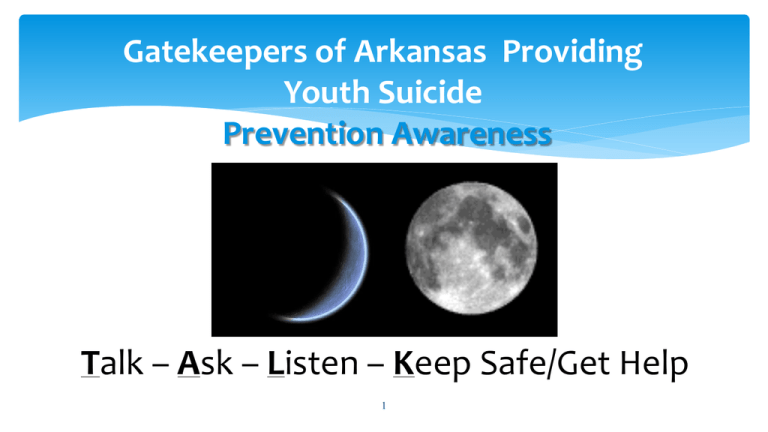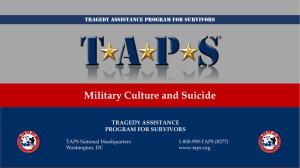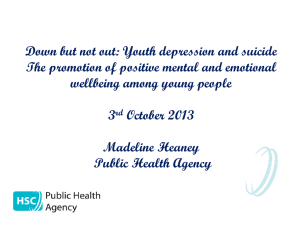
Gatekeepers of Arkansas Providing
Youth Suicide
Prevention Awareness
Talk – Ask – Listen – Keep Safe/Get Help
1
IT IS UP TO US TO PROVIDE YOUTH
SUICIDE PREVENTION
H
O
P
E
Portions of the slides prepared by Maine Youth Suicide
Prevention Program.
www.mainesuicideprevention.org
2
Today We Will Cover:
– Language, Statistics, and Myths about suicide
– Warning signs and risk factors
– Basic intervention skills to use with suicidal
behavior
– The aftermath of suicidal behavior
3
Language Considerations
Should Avoid:
MUST Avoid:
“committed suicide”
“completed suicide”
“JUST a cry for help”
“successful suicide”
“failed attempt”
Please USE:
Please USE:
“suicide” or “died
by/of suicide”
“non-fatal attempt”
“died by/of suicide”
“a suicide attempt”
4
Common Words & Phrases
Suicidal related communications include ideation - the direct
communication of thoughts, talk, sharing of plans that may
indicate a person is thinking about taking his/her own life.
Suicide Attempt: A self-inflicted, potentially injurious behavior
with a nonfatal outcome for which there is evidence of intent
to die.
Suicide: A self-inflicted death with evidence (implicit or
explicit) of the intent to die.
5
Suicide in Arkansas
Suicide is the 3rd leading cause of death for
Arkansas’ youth ages 15-24
Of every 5 suicides, 4 are males
Of every 15 suicides, 7 are by firearm, 4 by
hanging, 3 by drowning or poison.
6
Attempted Suicides
It is estimated that there are 25 attempted
suicides for each death by suicide
Attempted Suicides
Ratio implies 900,875 suicide attempts annually in USA
7
Suicide
11,175 Arkansans
Attempted Suicide by sex/gender
Estimated that there are:
3 female attempts for
each (1) male attempt
8
Attempted Suicide & Age
Attempted Suicides
Suicides
Young
100:1
65 & over
4:1
10
In the typical high school classroom:
1 male and 2
females have
probably
attempted suicide
in the past year
10
After an Attempt
Support family/friends
Acknowledge the impact, the fear
Avoid judging, blaming
Emphasize safety and removal of all lethal
means from household
Encourage appropriate help
11
Facts or Myths ?
1)
T or F
People who talk about suicide do not
actually die by suicide.
2) T or F
Suicide usually happens without
warning signs.
3) T or F
Talking or asking someone about suicide
may plant the idea and cause a suicide.
12
In Fact
Youth suicide is a problem.
We all need to learn about it.
Talking about suicide can save lives.
13
A Word About Young Children
SOME young children (ages 5-14) do understand the
concept of death, are capable of planning a suicide
and able to implement the plan.
It is a rare event, but we must not assume that
children can not or do not die by suicide. They do!
Some states have documented suicides in
children as young as 8 years old.
14
Definitions
Warning Signs - the earliest observable signs that
indicate the risk of suicide for an individual in the nearterm (within minutes, hours or days.)
Risk Factors - long standing conditions, stressful
events or situations that may increase the likelihood of
a suicide attempt or death.
Protective Factors - personal and social resources that
promote resiliency and reduce the potential of suicide.
15
Warning Signs
Useful Mnemonic: Is Path Warm?
Ideation Substance Abuse
Purposelessness Anxiety Trapped Hopelessness
Withdrawal Anger Recklessness Mood Change
16
Early Warning Signs of Suicide
Includes Behavioral, Emotional & Physical Signs:
Depressed / Anxious
Increased alcohol/drug use
“Roller coaster” moodiness
Changes in every day behaviors
Overly pessimistic, hopeless
Neglects self, friends, usual activities
17
Late Signs/Behaviors May Include:
Talks of suicide, plans for how/when/where
Refuses help
Agitated, restless, picks fights
Gives away favorite things, writes a will
Shows SUDDEN improvement in mood (suicide
euphoria)
Increased isolation
Uses instant messaging or phone to drop hints
18
Listen for Verbal Clues
Direct
I wish I were dead
I’m going to end it all
Indirect
I’m tired of it all
You’ll be better off without me
What’s the point of living?
19
20
Risk Factors for
Adolescent Suicide
•Depression, anxiety, or mood disorder
•Current or previous suicidal behavior
•Being a victim of sexual or emotional abuse
•Conduct problems
•Access to lethal means
21
Protective Factors
Supports - Supportive parents, friends, teachers &
other caring adults
Skills to think, communicate, solve problems, manage
anger
Purpose & value in life-hope for future
Personal characteristics - good health, positive
outlook, healthy choices
Safe Environment – restricted access to lethal means
22
Very Important to Remember…
There is a lot of cross-over between Risk
Factors and Warning Signs!
There is no particular set of risk factors that
accurately predicts imminent danger.
There is no “typical” suicidal person - there are
ALWAYS varying degrees of risk factors.
23
From a Suicidal Person’s Point
of View
Crisis point has been reached
Distress/torment/anxiety seems unbearable
Solutions to problems seem unavailable
Rational Thinking is affected
Ambivalence exists between wanting to live and
wanting to end the psychological pain
Need to communicate pain is intense!
24
Invitations to Help
FEELINGS
THOUGHTS
“All of my problems will end soon”
“No one can do anything to help me now”
“I wish I were dead”
“Everyone will be better off without me”
“I won’t be needing these things anymore”
“I can’t do anything right”
“I can’t think straight”
Desperate
Worthless
Angry
Lonely
Guilty
Sad
Hopeless
Helpless
ACTIONS
Giving away possessions
Withdrawal (family, friends,
school,
work)
Loss of interest in hobbies
Abuse/use of alcohol, substances
Reckless behavior
Extreme mood swings
25
PHYSICAL
Lack of interest in appearance
Changes in appetite, weight
Change in sleep patterns
Intervention--Why People Hesitate
Inability/lack of knowledge
Worry about doing/saying the “right” thing
Feelings of inadequacy
Belief in myths of suicide
26
What is NOT Helpful
Ignoring or dismissing the issue
Acting shocked or embarrassed
Challenging, debating or bargaining
Giving harmful advice
27
What IS Helpful
1) Show You Care—Listen carefully—Be genuine
“I’m concerned about you . . . about how you feel.”
2) Ask the Question—Be direct, caring and nonconfrontational
“Are you thinking about suicide?”
3) Get Help—Do not leave him/her alone
“You’re not alone. Let me help you.”
28
Practice Helpful Steps!
Use handout:
“What Is Helpful 3-Step Intervention”
1. Think up & write 1 or 2 phrases or ways that YOU
would use to “show you care.”
2. Write two other ways you might “ask the
question” about suicide.
3. List two ways you would try to convince someone
to “get help” and name two resources.
29
Resources for Help – Phone numbers
Arkansas Crisis Hotline 1-888-CRISIS2
(1-888-274-7472)
National Suicide Crisis Hotline 1-800-273-TALK
(8255)
• Or 1-800-SUICIDE (1-800-784-2433)
• En Español 1-888-628-9454
• TTY capability 1-800-799-4TTY (4889)
30
Resources for Help - Websites
National Suicide Prevention Lifeline
http://www.suicidepreventionlifeline.org/
MYSPP Web Site: www.mainesuicideprevention.org
Online Crisis Chat:
www.crisischat.org or www.arcrisis.org
31
School Resources for Help
School Administrators
School Counselors
Teachers & School Staff
School Nurses & Health Services
Social Workers
School Crisis Team
School Resource Officer
Any Trusted Adult
32
Our school protocol is…
When Any Concern Is Raised Contact:
Principal & School Counselor
School Crisis Team
Parent or Guardian
Have a Suicide (Risk) Assessment
Administered
33
Number of Suicide Survivors
It is estimated that there are
for each death by suicide
6 survivors
A
“suicide survivor”
is someone who
has lost a loved
one to death by
suicide
2,412
Arkansans
in 2008
34
Ratio implies 199,800 new survivors of suicide annually
Survivors of Suicide
Struggle to make meaning of the loss
Suffer from overwhelmingly complicated
feelings
May take a long time to grieve
Need understanding and support
Youth survivors have special issues
35
How you can help after a suicide
Acknowledge the loss
Share a special memory/story
Use the name of the deceased
Share your presence
Acknowledge the good things
Stay in touch
Call local hospice center for grief support groups
36
Factors Used in Estimating the Risk
of Suicide
Age: Certain ages more than others.
Gender: One gender more than the other.
Stress: Troubling experiences that challenge the
person’s ability to cope.
Warning Signs: Behaviors that can be observed
(Aggression, Sadness, Drug or Alcohol Abuse)
37
Additional Factors Used in Estimating
the Risk of Suicide
Current Suicide Plan: Whether or not there is a plan
and any details of that plan
Prior Suicidal Behavior: Personal history of suicide or
suicide attempt(s): including “modeling” by family,
friends or others
Resources/Protective Factors: Physical and emotional
resources which the person feels are helping, caring
or supportive
38
Estimate the Risk of Suicide
Your Rank
Rank
___ Age
5
___ Gender
4
___ Stress
6
___ Warning Signs
3
___ Current Suicidal Plan
1
2
___ Prior Suicidal Behavior
___ Resources/Protective Factors 7
39
Responders – Take Care of Yourself!
Acknowledge the intensity of your feelings
Seek support, de-brief
Share your feelings
Avoid over – involvement
Know that you are not responsible for another
person’s choice to end their life
40
“A LIFE SAVED”
The story on video we are about to see is true. It concerns a
suicide intervention that occurred only days after the end of a
suicide prevention learning unit done at a Maine middle
school health class.
It is told by the real student and guidance counselor involved.
No scripts were used, no rehearsals held and no special
lighting or sound systems. A high school student did the
actual digital filming.
41
Arkansas
Crisis Center
Business Office: (479) 756-1995
Fax: (479) 756-2338
Email: www.arcrisis.org
AR Crisis Hotline: 1-888-274-7472
42
Before You Leave…
Any Questions?
Thank You . .
For learning about suicide prevention
ADE Support: betty.welch@arkansas.gov roger.palmer@arkansas.gov
43










